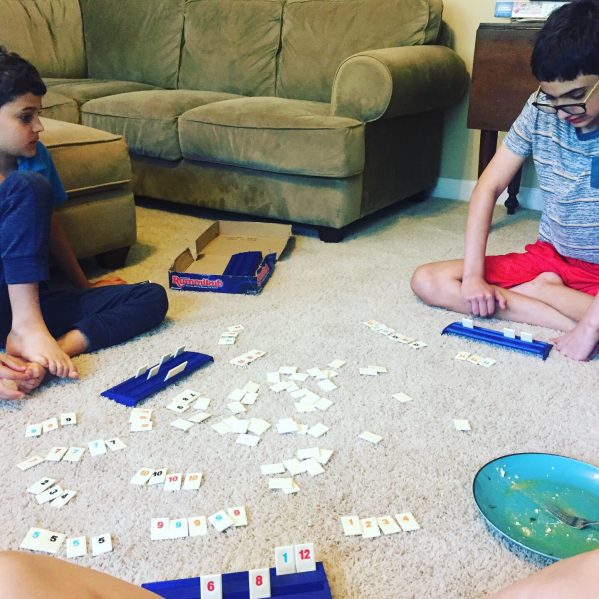If you’re of a certain age (eh-hem, late 30s and 40s), you’ll remember well the opening scenes of Mr. Roger’s Neighborhood, where the delightful Fred Rogers walks through his TV set’s front door, walks down the stairs, heads to the front closet, removes his dress coat, puts on a cardigan, takes off his dress shoes, puts on his sneakers, and then sits down to tell us about the day’s episode.
This daily ritual was purposeful. Pastor and psychologist Rogers knew that young children craved routine, and indeed, watching that opening sequence brings me, to this day, a sense of peace and serenity seldom found when I watch television.
Routine is necessary for maximum efficiency in life, and maximum efficiency is very often necessary for saving money.
If your life is highly routined, then you and the people you live with know what is coming. You can plan for it, and save for it. More importantly, your brain doesn’t have to waste precious neurons deciding how to manage unexpected decisions.
If you currently waste money repeatedly in the same way, a routine will allow you to examine that cost and change it so that you save yourself money again and again simply by making one decision at one point in time.
Let me break this idea down a bit more.

Breakfast
For most people, their breakfast routine is well-engrained. Even if you don’t eat breakfast, you have the same routine of walking into the kitchen, grabbing your coffee, and sitting down to drink it before you get dressed (or whatever your particular routine is).
Many highly efficient and frugal people have the breakfast routine down to a fine art. They eat the same meal each day for breakfast, maximizing their savings by choosing a low-cost, highly filling breakfast.
For example, Mrs. Frugalwoods eats oatmeal each day for breakfast. She estimates this breakfast costs her a meager $.10 per serving, only slightly more if she adds fruit. She made the decision to eat oatmeal many years ago and has continued to do so because of its low cost and health benefits.
Now that Mr. ThreeYear and I have begun to eat plant-based, we are deciding on a breakfast routine. Currently, we’ve settled on toast and peanut butter, but I think that oatmeal may be the better route for us, for the simple fact that it is cheaper and healthier. I haven’t yet figured out how to quickly make it each morning, though, or how to prepare it so that it’s filling enough for us, so that is a decision still-in-the-works. When it’s made, though, I look forward to a low-cost, highly-nutritious breakfast that we can eat every day.
Daily App Monitoring
One of the first things I do every morning is check my YNAB (budgeting) app. That helps me keep track of my daily purchases and make sure that we are staying in budget. I check the app every day, without fail, even on Sundays, when t doesn’t update my purchases. This is just part of my daily routine and helps me manage my money by categorizing expenses at the start of each day.
My dad doesn’t have a budget, but uses another daily routine to manage his spending. He only has two credit cards, and checks those credit card apps daily, each morning. If he sees his balance is too high, he will adjust his spending accordingly. He says “I think the constant reminders of what I’m spending help me reign in my expenditures, especially my fixed overhead.” Reviewing those costs that are charged to him again and again require him to think about whether or not they’re bringing him enough value to warrant the cost.
Clothing
My mom made the decision to buy almost all of her clothes from one store, Chico’s, and she only buys them when they’re on sale. Chico’s sends her an email, “Special 24-Hour Sale 50% Off.” The sales happen often enough that she rarely has to wait more than a few weeks to purchase the item she’s interested in.

Now that she has made the decision to shop exclusively at Chico’s, a store that she knows makes high-quality clothing that fits her well, she doesn’t have to spend time or energy looking at clothes in other stores. Also, because she has made the decision to only buy clothing on sale, she knows exactly when she can buy clothes (when they have their 24-hour sales, and when, of course, she’s in need of new clothing).
Now that I have minimized my wardrobe, I typically only buy clothing when something has worn out or is way out of style, and often, not even then. I got rid of my black boots last winter because they were seriously out of style and have gotten by with just my tan boots. I would like to get a new pair, but I will wait to do so until other priorities have been fulfilled (like buying a new furnace and AC…ugh). Even though I wear the same shoes almost every day, it’s no big deal and no one seems to notice.
We made the decision to buy Little ThreeYear’s shoes each year from our tennis shop, because they have sales to get rid of old inventory, and we usually buy a nice new pair of shoes for him for less than $20. This year, we got a new pair of Babolat shoes for him for $7.50.
Lunch
I eat one of two things for lunch each day–a salad or leftovers. I made this decision long ago and now don’t have to think about what to fix for myself. I just prepare my salad or, if I am running short on time or feeling extra-hungry, grab a container of leftovers from the fridge from our dinner last night.
I do not eat out for lunch (almost ever) so I always make my lunch and take it to school. There have been two days where I forgot my lunch this year, and my ritual was so finely engrained in my brain that I didn’t even think of going out for lunch. I just went to my car and grabbed the emergency pack of crackers that were there the first time I forgot my lunch, and waited until I got home to eat the second time (I only had to wait until 3pm so it wasn’t so bad).
Eating almost the same thing every day for lunch is great. I start salivating when I think about my delicious salad each day for lunch. It’s healthy and cheap because I don’t eat out, I eat up leftovers, and I can plan for exactly how much ingredients I will need each week.
Planning ahead and knowing what I will eat each day means I don’t need to make last minute decisions about food. Last minute decisions often involve considerable cost. Planning ahead and routine mean you can make decisions that are the most cost- and health-efficient.
Retirement
Some routines involve not rituals that we perform each day, but decisions that we make once, and then stick to again and again.
For example, you might make a decision to contribute the maximum to your 401k, set it, then forget it. That one decision, although not repeated daily, can make the difference between the ability to retire early or not.
Once you make the decision to have the retirement taken out, and get used to a slightly (or much) lower paycheck, you can forget about the decision and enjoy the benefits.
When I started my job as a Spanish teacher at the beginning of the last school year, I made the decision to max out my 401k. Since I never received a paycheck without having the entire 401k contribution taken out, I got used to the lower paycheck right off the bat, but now I get to enjoy the large 401k balance that comes from the decision.
Routine FTW
Mr. Rogers understood, so many years ago, that human beings, especially children, crave routine. Our brains can work on auto-pilot when we are engaging in predictable, expected behavior. When our lives are fairly predictable and routine, we’re freeing up extra brain space to focus on more important things, like enjoying our family members or learning a new skill.
Granted, I realize that it is something of a luxury to be able to structure a routined life. Some people have to juggle several jobs, are single parents, or otherwise cannot craft a predictable, routine life.
However, there are some of us who choose not to. It is very easy to make decisions that eat up all your free time and money, like signing kids up for multiple sports each season. If you are carting each of your three children around to multiple activities each evening, it’s no wonder you’re eating out every night or buying new sports gear on the fly when your kids have left theirs at home. There’s just not enough margin in your days to be able to plan well.

We made the decision many years ago that less is more when it comes to activities, and therefore we enjoy a lot of free time in our family. Even with all the free time we have, we still manage to cram in a lot of activities. But the more we develop our predictable and simplified routines, the better we feel and the more money we save.
How Do I Create a More Routine or Structured Day?
When I find life getting wacky, and our schedules veering off into busier and busier, I find that one of the best ways to get back on track is to stick to the basics. I make myself start getting up earlier and then make sure to get up before the rest of my family and accomplish some goal. Currently, that’s been writing blog posts once a week, writing articles for a website, or sometimes, doing schoolwork.
Starting the day off with an accomplishment that is my own and represents work that I enjoy and want to be doing is often a great way to hit the reset button on a wacky schedule.
When the beginning of my day starts on time and involves getting something accomplished, I tend to have a better day the rest of the day. I make better decisions about what to eat, which improves my mood. Then I can make better decisions about saying “no” to activities or purchases or trips to the store that suck up time and energy during my evenings.
Our best decision for creating a more routined schedule was only letting our kids pick one activity each to be involved in. They can focus on their one activity, learn dedication to that particular activity, and have lots of time and margin in their schedules to do other things they like to do. If they decide they don’t like the activity, they can make a change the following season or year.
I used to balk at routines as a kid, even as I loved them. Taking my bath, going to bed at the same time each night, having the same few meals again and again, could occasionally be frustrating, especially if I wanted to stay up late watching TV or eat out at a restaurant, but routine also provided predictability and calm in my life. It taught me patience (“You can watch TV some more tomorrow”) and it taught me that scarce resources, like eating out money, need to be apportioned.
Even though Covid-19 has created a lot of sameness for lots of us, it’s given our family the chance to create some more structured routines in our lives that have helped us save money and sanity (daily walks!).
What kind of routines have you made that have saved you money?



A pro-tip for oatmeal is that you can cook a large batch in the crockpot and then microwave it throughout the week. It tastes the same and is super convenient. Adding chopped nuts provides more protein along with some spices and then some fruit on the day you microwave it.
This is indeed a pro tip. I will have to try it because cooking it definitely takes awhile in the morning!
I get routines but ours are very fractured. We get up at maybe 7 on Sunday and Monday, 4:50AM on Tuesday and Thursdays to run, and on Saturday she’ll get up at 4:40 and I’ll get up at 5:20 because she runs longer distances that day. Wednesday and Friday its whenever I wake up, could be 6:30 or it could be 9AM. Unless we are going fishing then we might be up at 4:30AM. And we fish a lot. We also don’t eat the same thing for breakfast, which I usually cook. And never eat the same thing for other meals, we like to cook with a bunch of variety. I only set alarms on run days. But of course we are both retired so there is less of a reason to live by a rigid framework. But we always maxed the 401K plus a Roth or regular IRA and put a similar amount into taxable brokerage accounts because we had a pretty good income and a pretty moderate lifestyle. Those were the routines that made retirement slightly early so easy.
Wow-I’m seriously blown away by your wake up times. Do you guys train for specific races per chance or just run for yourselves?
I’ve found with oatmeal, to make it more filling is add peanut butter and chia seeds. And to make them quick(er), i get the water to boiling turn the stove off, dump the oats, peanut butter and chia seeds in, cover it and let it sit until i’m ready (usually after i shower). We don’t have a microwave, or i’d try Meg’s tip 😉
Thanks! I’ll try this!
This might sound gross, but I like oatmeal with raisins and wheat germ
No way! Sounds good!
As a stay-at-home mom to five, I have to applaud your decision to have your kids pick ONE activity at a time. When I was a new(er) mom and only had two kids, I looked around. It seemed that everyone had their kids in every sport or activity known to man. I quickly followed and found out how expensive and time-consuming it was! And for what!?! The kids (and I) got exhausted, and I couldn’t see how this would benefit them in 20 years. We took a step back and did exactly what you did-ONE activity. It saved our sanity, money, and time. Everyone is happier, and isn’t that the point?
Thanks Lynn! Five kids?! Wow! If having one activity per kid is a sanity-saver for me, I can only imagine how you feel!
Oatmeal is a staple for our morning meal. I also learned to make granola years ago as a stand in for healthy snacking for those of us who like a little more crunch. Lately I’ve been experimenting with making oat milk and have had good results
How do you make it? We like the oat-based yoghurt a lot.
My newest process for preparing steel cut oatmeal very easily is this method. It makes 4 portions so I’m good for several days! I add peanut butter, banana, chia seeds, and sometimes hemp seeds to make a plenty filling breakfast.
https://zerowastechef.com/2014/05/24/quick-easy-zero-waste-irish-oatmeal/
Love this. Thank you!!!
Most people like their daily routines since it gives them a sense of comfort and familiarity I guess. Routine for retirement investing is a good thing as well.
I was able to buy a bulk 50 lb bag of oats pretty cheap to start. I found that I had to add chopped banana, cinnamon, sugar, and a few spoons of plan yogurt to make it edible. I would boil enough water for oatmeal and a French press of coffee to speed up the routine.
You also mention 401k… and I had to encourage you to check if you can get a 457 as a teacher. The Millionaire Educator converted me as to why I needed to prioritize mine. For teachers, it can work as your penalty free early retirement account while you wait for a pension to kick in if you’ll get one.
Love Millionaire Educator. We have a 403b at our school, which I have definitely been taking advantage of. Maxed it out last year, but couldn’t this year with kids in private school. Still saving some!
Love the 50lb oats idea. I am going to look and see if I can find one at Costco.
I’m a big routine-resister, even as a 30-something, but I’m coming around on food. I’m trying to get the ingredients to cook three big weekend meals that have 2-4 dinners worth of leftovers each and then freezing all the leftover meals so that I have quick lunches and dinners to reheat or just bake on the weekdays. It’s been kinda fun to make a huge slew of enchiladas or a stack of lasagnas in only a little more time than making just one would take. Thanks for sharing!